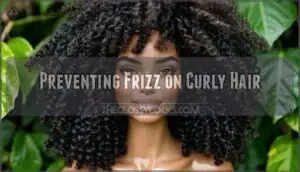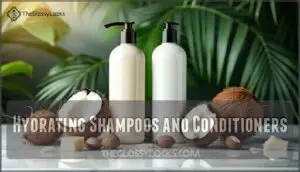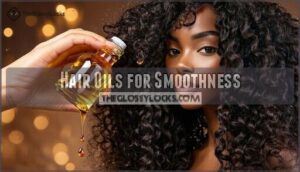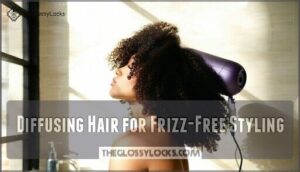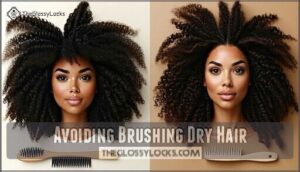This site is supported by our readers. We may earn a commission, at no cost to you, if you purchase through links.
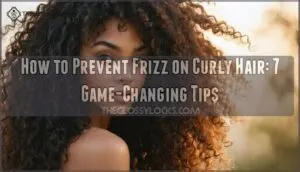
Start with sulfate-free shampoos and deep conditioning treatments to hydrate your curls from within. Use leave-in conditioners and lightweight oils to seal moisture and create a protective barrier against humidity.
When styling, gently squeeze out excess water with a microfiber towel instead of rough terry cloth, then diffuse on low heat to preserve your curl pattern.
Sleep on silk pillowcases to reduce friction, and never brush dry curls—this breaks up curl clumps and invites chaos.
The secret lies in understanding your hair’s unique needs and building consistent habits that work with your natural texture, and by doing so, you will be able to maintain properly moisturized hair.
Table Of Contents
- Key Takeaways
- Causes of Frizzy Hair
- Preventing Frizz on Curly Hair
- Moisturizing Curly Hair
- Styling for Frizz Control
- Managing Frizz Daily
- Frequently Asked Questions (FAQs)
- Why does my curly hair frizz so easily?
- How do I stop my curls from frizzing?
- Why does my curly hair get so frizzy?
- How do you fix dry frizzy curly hair?
- How can I improve my frizzy hair curls?
- Can I brush my hair when its dry?
- Whats the best way to dry my hair?
- Can I go outside after styling?
- How often should I cut my hair?
- Whats a clarifying shampoo?
- Conclusion
Key Takeaways
- Keep your hair properly moisturized – You’ll need sulfate-free shampoos, deep conditioning treatments, and leave-in conditioners to maintain hydration and create a protective barrier against humidity.
- Use gentle drying techniques – You should squeeze out excess water with microfiber towels instead of terry cloth, then air dry or use a diffuser on low heat to preserve your curl pattern.
- Protect your curls while sleeping – You can prevent overnight frizz by sleeping on silk pillowcases and using the pineapple method to loosely gather curls at the top of your head.
- Never brush dry curls – You’ll create instant frizz by disrupting your natural curl pattern, so only detangle when your hair is wet with conditioner, using your fingers or a wide-tooth comb.
Causes of Frizzy Hair
Understanding what causes frizz is the first step to taming your curls and achieving smoother, more defined hair.
Your hair becomes frizzy when moisture levels get out of balance, damage weakens the hair structure, or environmental factors like humidity wreak havoc on your curl pattern, leading to a loss of defined hair.
Frizz strikes when your curls fight an uphill battle against moisture imbalance and environmental chaos.
Humidity’s Role in Frizz
When humid weather strikes, your curls absorb moisture from the air, causing hair cuticles to swell and lift.
This disrupts your curl pattern, creating that dreaded frizz.
Higher dew points above 60°F spell trouble for curly hair frizz.
Your hair porosity determines how much humidity wreaks havoc—high porosity hair drinks up moisture fast, while low porosity resists but still struggles without proper hair hydration and antifrizz curly hair product selection for seasonal changes.
To combat this, consider how humidity can lead to increased frizz.
The Impact of Dryness
Dryness starves your curls of essential moisture, creating the perfect storm for frizz.
When natural oils can’t travel down twisted strands, your hair becomes parched and desperate for hydration.
Here’s how dryness impacts your curls:
- Oil Deficiency – Natural scalp oils struggle to coat curved hair shafts
- Cuticle Damage – Dry cuticles lift and create rough, frizzy texture
- Moisture Retention – Dehydrated hair absorbs humidity, causing swelling
- Frizz Severity – Dryness amplifies frizz formation and makes curls unmanageable
Damaged Hair and Frizz
When your curls face heat styling, chemical damage, or UV exposure, the hair cuticle breaks down like cracked pavement.
Heat damage cracks your hair’s protective barrier, leaving curls defenseless against frizz and moisture loss.
This mechanical stress creates holes that let moisture escape, making curly hair frizz worse.
Chemical treatments and protein imbalances weaken your hair’s structure, while everyday hair damage from brushing or tight styles adds to the problem.
The key is to maintain the hair cuticle’s integrity with proper care, understanding these hair protein disruptions helps you choose better hair treatments to keep your hair healthy.
Styling Mistakes and Frizz
Your styling choices can make or break your curly hair frizz battle.
Applying products to overly wet or too-dry hair disrupts wetness levels, creating frizzy, stringy curls.
Poor product layering and weak styler hold fail to control your curl pattern.
Heat damage from styling tools opens cuticles, inviting humidity in.
Using glycerin-packed shampoos can help nourish and protect hair.
Master air drying and proper curly hair styling techniques to prevent curly frizz effectively.
Product Build-up and Frizz
Product buildup turns your curly hair into a frizzy nightmare. Heavy styling products, co-washing residue, and hard water minerals create layers that block moisture and weigh down your curls.
Watch for these buildup red flags:
- Your hair feels greasy yet dry at the same time
- Curls look limp and lifeless despite using your usual products
- Scalp feels itchy or irritated from clogged follicles
Regular clarifying shampoos and ingredient awareness help maintain scalp health through smart product cycling, which can prevent buildup.
Preventing Frizz on Curly Hair
Managing frizz successfully requires understanding your hair’s unique needs and establishing consistent routines. You can’t eliminate frizz completely, but you can control it through strategic approaches that work with your natural texture instead of against it.
Frizz Prevention Strategy Guide
| Prevention Method | Frequency | Key Benefits |
|---|---|---|
| Curl Clumping techniques | Every wash day | Groups strands together, reduces individual frizz |
| Product Layering (LOC method) | Daily styling | Seals moisture, creates protective barrier |
| Humectant Use (glycerin products) | Low humidity days | Attracts moisture to hair shaft |
| Protein Balance treatments | Monthly | Strengthens hair structure, prevents breakage |
Start with proper Trim Frequency – every 6-8 weeks removes damaged ends that contribute to frizz. Focus on frizzy hair solutions that address your specific curl pattern. Hair serum for frizz works best when applied to damp hair before styling. Using leave-in conditioner can also help control frizz. The key is consistency – your curly hair needs predictable care to control curly frizz effectively.
Moisturizing Curly Hair
Proper hydration is the foundation of frizz-free curls, and it starts with choosing the right products for your hair’s unique needs.
You’ll want to build a moisture-rich routine that includes sulfate-free shampoos, nourishing conditioners, and protective oils that work together to keep your curls smooth and defined.
Hydrating Shampoos and Conditioners
Your hair craves moisture like a sponge soaks up water.
Sulfate-free shampoo gently cleanses without stripping natural oils, while hydrating conditioners with shea butter and coconut oil penetrate parched cuticles.
This ingredient analysis reveals why 96% of users see more defined curls after three weeks.
For those seeking gentle cleansing, consider options for buying shampoo without sulfates.
Co-washing between shampoo days maintains scalp health.
Product layering these hair moisturizers helps hydrate curly hair effectively, using a sulfate-free approach.
Leave-in Conditioners and Deep Conditioners
Your curly hair’s thirst for moisture doesn’t end at rinse-out conditioner. Leave-in conditioners and deep conditioning treatments work together to lock in hydration and banish frizz for good.
For coily hair, consider using leave-in conditioners for hydration and protection.
- Leave-in benefits: Creates a protective barrier that shields your curls from humidity
- Deep conditioning: Weekly treatments penetrate hair shafts for intense moisture repair
- Application techniques: Apply leave-in conditioner to damp hair, focusing on mid-lengths and ends
- Product layering: Use deep conditioning treatment first, then follow with leave-in conditioner for maximum frizz control
Hair Oils for Smoothness
Natural oils work like tiny shields for your curls, locking in moisture and blocking humidity that causes frizz.
Apply lightweight oils like argan or jojoba to damp hair, or try heavier coconut oil for thicker textures.
These hair moisturizers strengthen strands and boost shine when used consistently.
| Oil Type | Best For |
|---|---|
| Argan Oil | Fine curls needing lightweight moisture |
| Coconut Oil | Thick hair requiring deep conditioning |
| Jojoba Oil | All curl types seeking balanced hydration |
Styling for Frizz Control
Your styling routine can make or break your fight against frizz.
The way you dry, detangle, and handle your curls during the styling process determines whether you’ll end up with smooth, defined spirals or a frizzy mess that defies all logic.
Your styling routine can make or break your fight against frizz.
The way you dry, detangle, and handle your curls during the styling process determines whether you’ll end up with smooth, defined spirals or a frizzy mess that defies all logic.
Microfiber Towels and Gentle Drying
Since terry towels can roughen your hair cuticles like sandpaper, switch to a microfiber towel for gentle drying.
The microfiber benefits include reduced friction and smoother strands. You can find various towel options online.
Try the plopping technique by wrapping damp curls in the microfiber towel for 10-20 minutes. This method removes excess water without disturbing your curl pattern, making air drying more effective for ultimate frizz control.
Diffusing Hair for Frizz-Free Styling
After gentle drying, your diffuser becomes your secret weapon against frizz. The key lies in mastering the right approach for curly hair styling.
Here’s your roadmap to frizz-free diffusing:
- Choose low heat settings – High temperatures damage your hair cuticles
- Select the right diffuser types – Bowl attachments work best for curls
- Master the hovering technique – Keep distance to prevent disruption
- Perfect your product pairing – Apply gel before diffusing
- Compare air drying vs diffusing – Diffusers offer better control
Technique matters more than equipment when hair drying. Finding the right diffuser attachment online can substantially improve your results.
Avoiding Brushing Dry Hair
You’re about to make a huge mistake if you grab that brush for dry curly hair.
Brushing dry curls destroys curl definition and creates instant frizz by breaking the natural curl pattern.
Instead, detangle when hair’s wet with conditioner using your fingers or a wide-tooth comb.
| When to Detangle | Best Tools |
|---|---|
| Wet hair with conditioner | Wide-tooth comb |
| Shower with product | Fingers/hands |
| Never on dry hair | Detangling brush |
Managing Frizz Daily
Managing frizz doesn’t have to be a daily battle when you know the right strategies.
With consistent protective habits and smart styling choices, you can keep your curls smooth and defined all day long.
Nighttime Protection for Frizzy Hair
Your best defense against overnight frizz starts with silk pillowcases or satin scarves.
These sleep products reduce hair breakage by minimizing friction while you toss and turn.
Try the pineapple hair method – loosely gather your curls at the very top of your head using a silk scrunchie.
Silk bonnets offer complete protection, while gentle braiding techniques keep unruly strands contained without crushing your curl pattern.
Reducing Friction and Preventing Frizz
How can you shield your curls from daily friction that sabotages your styling efforts? Friction creates the perfect storm for frizz, but strategic protection keeps your curls intact.
- Switch to silk pillowcases – they reduce overnight friction by 43% compared to cotton
- Use microfiber towel hair drying – gentler than terry cloth for wet detangling
- Choose protective hairstyles – loose braids or silk scrunchies prevent breakage
- Apply gentle accessories – avoid tight bands that create friction points
- Practice proper frizz prevention – handle curly hair minimally when dry
Common Mistakes to Avoid for Frizz-Free Hair
Beyond protecting your curls at night, you’ll want to sidestep these common frizz-causing blunders.
Over-conditioning makes hair too soft and fluffy, while protein overload creates brittle strands.
Heat damage from styling tools wreaks havoc on your cuticles, and product buildup weighs down curls.
Improper drying with terry towels ruffles everything up, leading to the need for smoother curly hair care.
Skip these mistakes for smoother curly hair care.
Deep Conditioning for Extra Moisture and Hydration
Your curly hair craves regular deep conditioning to combat frizz and maintain moisture balance. Weekly treatments penetrate the hair shaft, delivering hydration that daily conditioners can’t match. Heat application during deep conditioning opens cuticles, allowing better ingredient penetration and maximizing moisture retention.
Three DIY Deep Conditioners for curly hair:
- Avocado and honey mask – Mix one ripe avocado with two tablespoons honey for intense hydration
- Coconut oil and egg treatment – Combine melted coconut oil with one egg for protein/moisture balance
- Shea butter and aloe vera blend – Mix equal parts for gentle, long-lasting moisture
Deep conditioning frequency depends on your hair’s porosity and damage level. Low-porosity hair needs weekly treatments, while high-porosity curls may require twice-weekly sessions.
Exploring Different Haircuts for Curly Hair
Strategic haircuts reveal your curls’ true potential while taming frizz.
Layered cuts reduce bulk and enhance definition, preventing the dreaded triangle effect.
Deva Cut techniques work curl-by-curl on dry hair, customizing each strand’s needs.
Bob lengths and pixie cuts minimize maintenance while showcasing texture.
Regular hair trims every 4-6 months prevent split ends that worsen frizz, keeping your hair type healthy and manageable.
To further enhance curl definition, consider trying the plopping technique.
Frequently Asked Questions (FAQs)
Why does my curly hair frizz so easily?
Like a sponge desperately seeking water, your curly hair’s unique structure makes it prone to frizz.
The twists and bends prevent natural oils from coating strands, leaving hair dry and keen to absorb humidity from the air, which swells cuticles and creates that familiar fuzzy texture.
How do I stop my curls from frizzing?
Use sulfate-free shampoo, apply leave-in conditioner on damp hair, scrunch with microfiber towels, air dry completely, and seal with natural oils like jojoba to lock moisture in.
Why does my curly hair get so frizzy?
Your curly hair gets frizzy because natural oils can’t easily travel down twisted strands, leaving them dry and desperate for moisture.
This causes your hair to absorb humidity from the air, swelling the cuticles and creating that dreaded frizz effect.
How do you fix dry frizzy curly hair?
Deep condition weekly, use sulfate-free shampoo, apply leave-in conditioner on damp hair, seal with natural oils, and air dry with microfiber towels to restore moisture and definition.
How can I improve my frizzy hair curls?
You’ll transform frizzy curls by mastering moisture balance, using curl-specific products, and protecting hair from humidity. Focus on gentle techniques, proper drying methods, and consistent deep conditioning routines.
Can I brush my hair when its dry?
No, you shouldn’t brush dry curly hair.
This damages your curl pattern and creates frizz.
Instead, detangle wet hair with conditioner using fingers, wide-tooth comb, or detangling brush in small sections.
Whats the best way to dry my hair?
Air drying is your best bet for minimizing frizz.
If you’re in a hurry, use a diffuser on cool setting.
Pat hair gently with a microfiber towel or cotton t-shirt instead of rubbing with regular towels.
Can I go outside after styling?
Yes, you can go outside after styling your curls.
Just let them dry completely first – wet hair is more vulnerable to frizz from humidity and wind.
Consider weather conditions and use protective products if needed.
How often should I cut my hair?
Cut your curly hair every 6-8 weeks to prevent split ends and maintain healthy curl patterns.
Regular trims eliminate damaged ends that contribute to frizz, keeping your curls bouncy and defined.
Whats a clarifying shampoo?
A clarifying shampoo’s your hair’s reset button – it strips away buildup from products, hard water, and oils that regular shampoos miss.
Think of it as a deep clean for your curls.
Conclusion
Picture your curls bouncing with life, free from the wild chaos of frizz that once ruled your mornings.
You’ve learned how to prevent frizz on curly hair through proper hydration, gentle handling, and protective styling techniques. Your consistent routine with sulfate-free products, microfiber towels, and overnight protection creates a shield against humidity’s attacks.
Remember, your curls aren’t the enemy—they’re your crowning glory waiting to shine with the right care and patience.
- https://tidd.ly/3xNFLQ3
- https://www.tootilab.com/CURLSBYTHECOAST
- https://controlledchaoshair.com/blogs/curly-hair-news/what-does-humidity-do-to-curly-hair
- https://themorfose.com/blogs/news/how-to-prevent-and-manage-frizzy-hair-in-humid-weather
- https://www.redken.co.uk/education/delete---old-hair-principles-and-fundamentals/science-of-curly-hair

